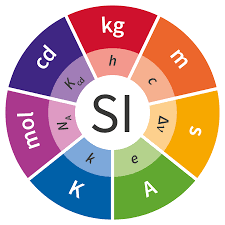From 20 May 2019 all SI units are defined in terms of constants that describe the natural world. This assures the future stability of the SI and opens the opportunity for the use of new technologies, including quantum technologies, to implement the definitions.
The SI is the system of units in which
- the unperturbed ground state hyperfine transition frequency of the caesium-133 atom ΔνCs is 9 192 631 770 Hz
- the speed of light in vacuum c is 299 792 458 m/s
- the Planck constant h is 6.626 070 15 x 10–34 J s
- the elementary charge e is 1.602 176 634 x 10–19 C
- the Boltzmann constant k is 1.380 649 x 10–23 J/K
- the Avogadro constant NA is 6.022 140 76 x 1023 mol–1
- the luminous efficacy of monochromatic radiation of frequency 540 x 1012 Hz, Kcd, is 683 lm/W
where the hertz (Hz), joule (J), coulomb (C), lumen (lm), and watt (W), are related to the units second (s), metre (m), kilogram (kg), ampere (A), kelvin (K), mole (mol), and candela (cd), according to Hz = s–1, J = kg m2 s–2, C = A s, lm = cd m2 m–2 = cd sr, and W = kg m2 s–3.
Prior to the historic vote by the BIPM's Member States on 16 November 2018 to revise the SI, the SI was defined in terms of seven base units and derived units defined as products of powers of the base units. The seven base units were chosen for historical reasons, and were, by convention, regarded as dimensionally independent: the meter, the kilogram, the second, the ampere, the kelvin, the mole, and the candela.






